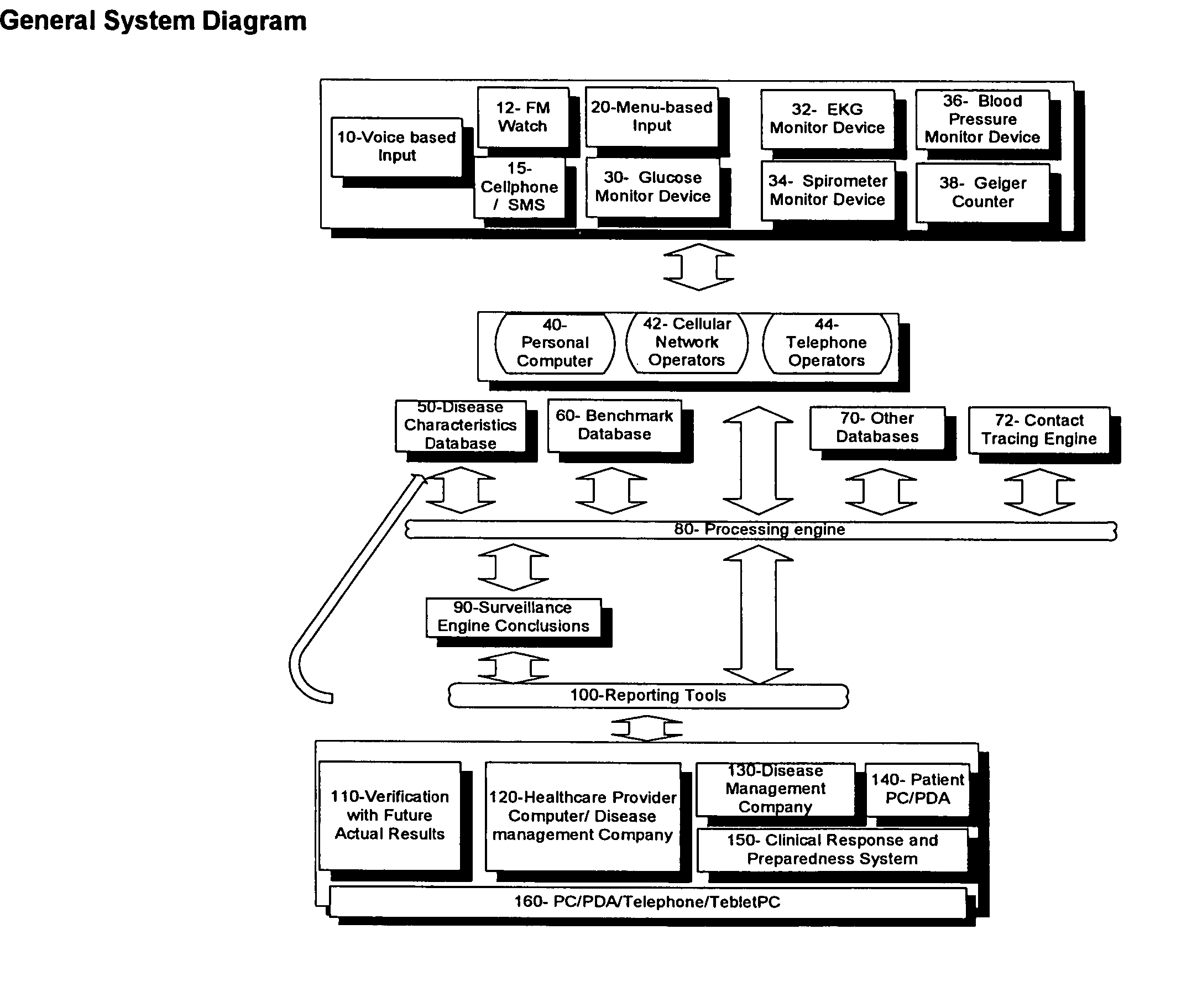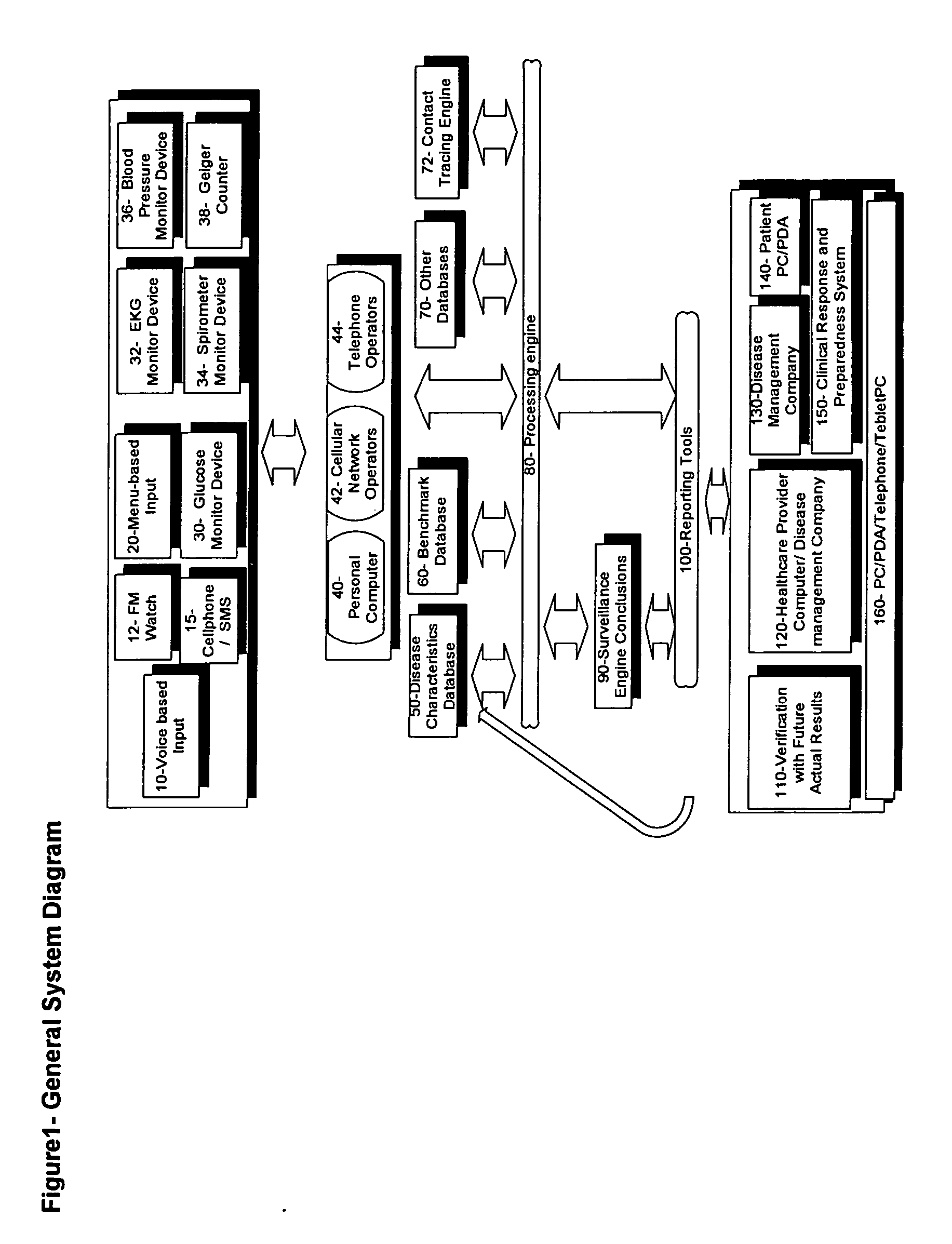Method for accessing and analyzing medically related information from multiple sources collected into one or more databases for deriving illness probability and/or for generating alerts for the detection of emergency events relating to disease management including HIV and SARS, and for syndromic surveillance of infectious disease and for predicting risk of adverse events to one or more drugs
- Summary
- Abstract
- Description
- Claims
- Application Information
AI Technical Summary
Benefits of technology
Problems solved by technology
Method used
Image
Examples
form examples
[0250] Following are examples of forms that will be used in the system. These forms will come as template forms. Site administrators with the appropriate permissions will be able to change the forms using the administration tools.
Triage Form
[0251] Triage Forms can be used during the process of registration of new patients and follow up of registered patients. Triage form includes [0252] Demographic information (If follow-up, auto-completed) [0253] Weight measurement [0254] Determined reason for visit [0255] Interval history from last visit [0256] Recording of new chronic problems. [0257] Check record for TB [0258] Referral to health worker if necessary
Education and Support Cards
[0259] These are special forms that, according to the treatment selected for the patient guide the medical and lay staff in educating the patient, and explaining the course of treatment. Unlike some of the other forms, education forms are pre-set, and are not intended to collect data, but rather to deli...
example 1
A Custom Client Solution
[0583]FIG. 12 demonstrates data and view components that can be used to create a custom client application that does not use SharePoint. Note that, as mentioned above, such a solution can be used both when a very simple solution is desired (whereas SharePoint might not be necessary), or a complicated solution, whereas SharePoint alone may not suffice.
[0584] In this example, a custom web application is developed to serve as a document management view, with InfoPath serving as the document viewer and editor.
[0585] The following steps explain a typical usage scenario for the example. [0586] a. The user (1 in FIG. 12) uses the custom web application (2) as the main application, viewing task lists, timed events etc., and also document lists (typically FORMs). For example, a FORM list can include a set of FORMs awaiting the user's approval via a digital signature. [0587] The data content of the lists is retrieved from the Document Server (3), which accesses the ...
example 2
A SharePoint-Based Solution
[0600]FIG. 13 demonstrates the data and view components that can be used to create a solution that takes advantage of SharePoint's features.
[0601] In this example, a SharePoint solution is developed as a document management view, possibly enhanced with various GDH-developed “Web-Parts” integrated into the main views.
[0602] To display a list of FORMs similar to the previous example, SharePoint first needs to learn of the content of the list. Since we do not use SharePoint for the storage of the FORM documents themselves, we need to use an agent that will communicate between our storage system and SharePoint. This is what the SharePoint Agent does.
[0603] The following scenario explains the steps how a document becomes accessible from a SharePoint application: [0604] a. Assume that a new FORM is added (by any process) to the database (4). [0605] b. The SharePointAgent (7 in FIG. 13) detects the new FORM and updates the SharePoint Content Database (8) usin...
PUM
 Login to View More
Login to View More Abstract
Description
Claims
Application Information
 Login to View More
Login to View More - R&D
- Intellectual Property
- Life Sciences
- Materials
- Tech Scout
- Unparalleled Data Quality
- Higher Quality Content
- 60% Fewer Hallucinations
Browse by: Latest US Patents, China's latest patents, Technical Efficacy Thesaurus, Application Domain, Technology Topic, Popular Technical Reports.
© 2025 PatSnap. All rights reserved.Legal|Privacy policy|Modern Slavery Act Transparency Statement|Sitemap|About US| Contact US: help@patsnap.com



